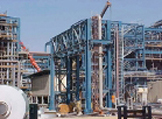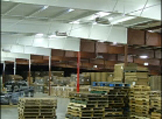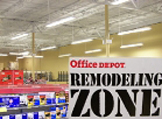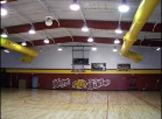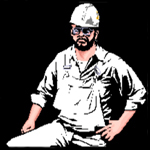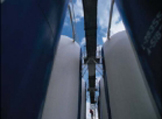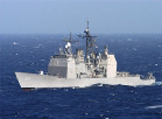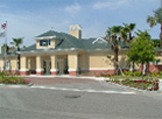Safety Policy

Safety Policy
1. CREWMEMBER SAFETYYour safety is our highest priority. Safe working conditions are a major concern to the management of this company and to our insurance carrier. When we are safe and accident free, our insurance rates are lower, our overhead expense is lower, and we will win more jobs to keep you employed. When we're not safe, our costs go up and we win less work.
We have adopted the expression "Better Safe Than Sorry." Please follow these basic guidelines!We all know that there are many hazards on a job. Most of the injuries that occur are the result of falls. That's why it's so important that we all follow the basic fall-protection rules, especially those concerning ladders and scaffolds. Two other common physical hazards are noise on the job and temperature extremes, both heat in the summer and cold in the winter.
2. LEARNING SAFETYBecause our crewmembers are one of our most important assets, we are quite concerned about your safety. Careful planning, training, and respect for the basic safety rules will help keep accidents to a minimum.
Crewmembers are charged with reading and abiding by the company safety policy and each crewmember will be responsible for performance of their work in the safest possible manner and in accordance with all applicable local, state and federal safety and health regulations as well as the customers safety policies and practices.
- Foremen will conduct toolbox safety meetings every other week (once in ten working days).
- Foremen will issue safety letters to existing and new crewmembers.
- Crewmembers shall attend all toolbox safety meetings.
- Read signs and obey company safety policies.
- Wear and use all protective equipment and devices.
- Always pay attention to what you are doing.
- If you are unsure how to do a job, ASK FOR HELP.
- Never try to operate a piece of equipment that you are not familiar with.
- Use approved warning and instructional signals.
- Inspect safety equipment and gear frequently.
- Running in aisles, corridors, and/or stairways is absolutely prohibited.
- When walking, particularly at blind corners, keep to the right.
- When opening doors, do so slowly to avoid striking anyone on the other side.
- Fooling around, roughhousing, or general carelessness will be permitted.
- Keep walks, aisles, stairways, and all other passageways clear of all obstructions.
- Maintain a clean and safe work area.
- Supply every vehicle with a first aid kit and fire extinguisher.
- Report all unsafe and potentially dangerous conditions and practices to your Foreman or supervisor.
- Report any and all accidents of crewmembers immediately to your foremen or supervisor.
- Report any product spills, leaks or wet spots immediately. Make sure they are cleaned up as soon as possible.
The four situations when the body is most prone to strains are:
- Manually handling heavy objects
- Exerting extreme force to release something stuck
- Attempting to "recover" unbalanced equipment
- Assuming an unsafe position or exerting pressure
Remember theses phrases:
- STOP AND THINK: Is it too heavy for me alone?
- BEND YOUR KNEES - NOT YOUR BACK
- KEEP IT CLOSE
- DO NOT TWIST
Assuming an unsafe position or exerting pressure is usually a result of a lack of room to work and/or poorly planned work.
What ever you're lifting (a can, a drum, a board), use the six basic steps:
- Feet parted - one alongside and one behind the object.
- Keep back straight, nearly vertical.
- Keep your chin tucked in.
- Grip the object with the whole hand.
- Keep your elbows and arm tucked in.
- Keep your body weight directly over the feet.
Be advised of the potential hazards of using an airless sprayer outside. Over-spray can carry in the wind for miles and damage other property.
Anyone using an airless sprayer outside is required to check with the Foreman each time before proceeding. This requirement insures that accidents do not occur.
The Foreman will be responsible if any problems arise, IF the crewmember checks first with him. If a crewmember proceeds using his/her own discretion and spray paints without authorization, the crewmember will be held personally responsible for any and all damage that may occur from over-spray carried by the wind.
6. SPRAYER SAFETYNever spray paint in unvented areas. Fumes can cause serious illness or injury. Spontaneous combustion can also cause an explosion if ignition occurs in a confined area. Do not smoke, weld, burn or use open flames in the vicinity when spray painting. Use protective equipment such as facemasks, respirators, sock, hats, hard hats, and eye protection.
7. COMPRESSED AIR SAFETYCompressed air and/or compressed gas can be very dangerous. Please follow these basic guidelines for your protection:
- Compressed air shall not be blown toward your self or any other crewmember.
- Do not use dusting clothing or any other part of the body dusting.
- A properly rated PSI air blowgun is mandatory when using external air for cleaning.
When you work with paints, coatings, dusty materials, adhesives or anything else that you can breathe, good ventilation is the key. It is recommended that you set up fans to blow the contaminant away. Be sure you don't blow it at someone else though.
It may be necessary to wear a respirator to keep your exposure, or the amount that enters your body, at a safe dose. If you use a respirator, be sure you use the right type. Respirators either filter out the contaminant or provide fresh air to breathe. Ones that are good at filtering dust usually don't do you any good when the hazard is a vapor, fume or gas.
Fresh air-supplied respirators may be necessary when working in tight places with a hazardous material, or when working in a tank or sewer where there is a lack of oxygen to breathe. Don't fool around. If you need a respirator, choose the correct one, learn how to use it, and then make sure it fits tightly when you wear it.
9. RESPIRATOR SAFETYTo assure the proper adequacy of a respiratory protection program, monitoring of work areas will be conducted on a periodic basis to provide for a continuing healthful environment for crewmembers.
- Pre-employment physical exams are conducted on all crewmembers to assure that they are in adequate healthy condition to use respiratory equipment as required.
- Periodic physical exams will be given to regular crewmembers in order to assist them in maintaining their health.
- Biological monitoring in the form of blood/urinary analysis will be conducted on a periodic basis for all crewmembers, if appropriate.
- Respirators are selected and approved by Management. The selection is based upon the physical and chemical properties of the air contaminants and the concentration level.
- Foreman must instruct each crewmember, upon assignment to an area requiring respirators as to how to use a respirator.
- Crewmembers required to wear a respirator must be fitted properly and tested for a face seal prior to use of the respirator in a contaminated area.
Respirator Inspection and Maintenance:
- The wearer of a respirator will inspect it daily whenever it is in use.
- Foremen will periodically spot check respirators for fit, usage, and condition.
- Respirators not discarded after one shift use, will be cleaned on a daily basis.
- Respirators not discarded after one shift use, will be stored in a suitable container away from areas of contamination.
- If use by more than one crewmember is required, the respirator will be cleaned between uses.
- Each area requiring the regular use of respirators will maintain a logbook.
- Crewmembers not discarding respirators after one shift should sign this logbook daily in order to document the inspection and maintenance of the respirators.
Self-contained breathing apparatus may be required in specific areas for emergency use. Only trained personnel will use this equipment when the job requires entrance into hazardous atmospheres.
10. HAND TOOL SAFETY- All painters must provide their own tools to satisfy the minimum tool requirements.
- Use only tools and equipment in good condition and only for the purpose, which they were designed for.
- When the proper and safe tools are not available for the work at hand, report this fact to your Foreman.
- Inspect tools at regular intervals and remove from service any tools which are defective.
- Do not use impact tools such as hammers and wedges with mushroomed heads.
- Check hammers and similar tools for loose, cracked, or splintered handles.
- Do not use razor blades for cutting operations unless they are contained in a proper holder.
- Do not use a piece of pipe or other extension on wrench handles to increase leverage unless the wrench is specifically designed for use of such extensions.
- When working with extension cords and air hoses, do not allow them to be left lying in aisles or walkways.
- Never carry pointed objects such as pencils, knives or screwdrivers with the point exposed in your pockets.
- Keep tools away from where they may cause regular walk-through traffic a stumbling hazard, or where they may fall or strike someone.
- Store sharp-edged or pointed tools with the edge or point guarded at all times when not in use.
- Your Foreman has the right to inspect your personal tools and ask you to remove defective tools from the premises.
- Upon completion of a job, it is your responsibility to store tools properly in the storage areas provided.
Safety belts help stop falls. You should always wear a safety belt, when guardrails are not practical and any time there is a possibility of falling more than six (6) feet. It is the responsibility of every crewmember to check belts for proper care and maintenance. If there is a problem, report it to your Foreman.
- Keep belt and tail line away from sources of artificial heat.
- Wash and dry where air can freely circulate, if the belt and line are dirty and wet.
- Examine for cuts or abrasions before use.
- It is best the belt catches you as soon as you start to fall, so tie off the tail line above your head.
- If anything is questionable, turn the equipment in for repair or replacement.
- All portable ladders must have safety feet. Be sure that any ladder you plan on using has safety feet.
- Place ladders on firm, level ground with the proper angle to the wall or surface before climbing.
- When you are using a ladder, position it so that it is not placed less than 1/4 of it's length from the wall or supporting surface, and not more than 1/3 of the working length.
- When using a stepladder, be sure that it is fully opened.
- When climbing a ladder, always face the ladder, use both hands, and do not skip rungs while climbing.
- Do not climb higher than the third rung from the top on straight ladders or extension ladders, and no higher than the second rung from the top stepladders.
- Don't stand on the top two steps or on the foldout shelf.
- Check your footwear prior to climbing to be sure they are free of grease, oil or other slippery substances.
- Use single (double) cleat ladders up to 30 feet.
- Use ladders, secured against sliding for climbing or descending the scaffold.
- Use only heavy-duty ladders and wood ladders with metal wire supports below each rung.
- When using metal ladders, stay clear of power lines.
- Move the ladder periodically so you are always at a comfortable reach.
- Secure your paint can to the ladder while painting.
- Inspect the condition of your ladders regularly.
- Erection of scaffolds is to be supervised by qualified personnel.
- Inspect scaffolds daily before use. Check all parts, guardrails, connectors, fastenings, tie-ins, and bracing.
- Climbing on scaffolding frames is prohibited.
- Planking is to be nominal structural plank.
- Split or unsafe planks must be removed.
- All scaffold frames shall have x-braces on one length.
- Base plates shall be installed on all scaffold legs.
- All scaffold legs shall be placed on firm sills.
- Provide solid support for sills, which extend over trenches.
- Platform slopes are not to exceed 2 feet in; 10 feet with secured planks.
- Keep platforms closely boarded, fenced and secured.
- Do not stockpile materials on scaffolds. Remove all materials and tools at the end of each day.
- NEVER overload scaffolds. Pile materials being worked over ledger and bearer points to minimize platform loading.
- Do not work on scaffolds during storms or high winds. Clear platforms of all ice and snow before using. Sand wet planking to prevent slipping.
- Protect scaffolding - do not bump or strike against scaffolds with vehicles or materials. Control hoisted material from the ground with tag lines.
- Keep platforms and area around scaffold cleared of debris, unneeded equipment, material and other hazards that can cause you to trip or fall.
Every year, workers are killed or seriously injured when the machine or equipment they are working on is started unexpectedly.
The danger is increased when there are crewmembers from other companies present. Therefore, it is an absolute necessity to implement a rigid plan for lockout or tagging when crewmembers are working on machinery or equipment.
Many job sites where we work have their own system already in effect and it is important to abide by their rules and coordinate our needs with them before beginning work. The first day on the job, the lockout plan used must be carefully reviewed allowing plenty of opportunity for questions. The procedure must be reviewed with all new and transferred crewmembers thereafter.
Items that may require lockout or tagging include:
- Manually operated electrical circuit breakers
- Disconnect switches
- Air, hydraulic, and steam valves
- Switches
Checklist for lockout:
- After locking out, test the equipment to be sure it is not operational.
- Return controls to the off or neutral position.
- Do not overlook other connected sources of energy stored in the unit after it is disconnected, (i.e.; fluid under pressure).
- Only the person who installed the lock should remove it.
- Survey the area before restoring power.
- Smoke only in designated areas.
- Immediately report any fires, no matter how small.
- Know where the fire extinguishers are located and how each is to be used.
- If you find an extinguisher partially used that needs recharging, or one with its seal broken, report it to your supervisor immediately.
- Know where the fire exits are and be prepared to show other crewmembers, should the need arise.
- Do not let fumes accumulate in contained areas. Fires started in these areas are a major cause of damage.
- Keep fire doors, fire exits and fire stairs clear of material and equipment on job sites.
- Dispose of waste and other debris promptly so as to remove any hazardous conditions.
- Flammable liquids are to be stored in approved containers, which MUST be labeled as to their contents.
- Do not use, or even go near open flames while wearing clothing contaminated with paint, thinner, or other flammable substances. If your clothing becomes saturated with flammables, change into clean uniforms.
Learn these classifications so you will be able to use the right material to extinguish a fire.
- CLASS A: USE WATER TO EXTINGUISH on rubbish, wood, paper, etc. fires.
- CLASS B: USE FOAM TO EXTINGUISH OR A BOX OF BAKING SODA on oil and gas fires.
- CLASS C: USE CO2 TO EXTINGUISH electrical fires.
Fire is a rare occurrence, but an ever-present hazard. Our first objective is to prevent fires by reducing hazards. Our second objective is to know what to do in the event a fire breaks out.
- GIVE THE ALARM - First, give the alarm. Notify your Foreman, be sure to give the exact location of the fire and the materials involved.
- EXTINGUISH SMALL FIRES - Use hand extinguishers.
- FIRE OUT OF CONTROL - If the fire is out of control, or there is dense smoke, evacuate the premises. Learn the location of your nearest fire exit.
Generally, in the painting industry, tools and equipment used do not cause noise problems. Frequently we send our crewmembers to work at locations where loud machinery is in operation.
Please follow these basic guidelines for your protection:
- Anytime the noise exposure level exceeds 90 decibels, suitable hearing protection shal be worn.
- Earplugs reduce noise levels by 25 to 30 decibels, when properly used and fitted.
- Earmuffs can reduce noise levels by 35 to 45 decibels.
- Improper fit of ear protection may completely destroy its effectiveness for hearing protection. Make sure equipment fits.
Ear protection does not make normal sounds more difficult to hear, when talking and warning signals can be heard in noisy environments without using ear protection, they can still be heard with it.
17. EYE PROTECTIONProtecting your eyes is a concern anytime there are flying particles such as those from grinding, insulation work, or overhead painting. Be sure if this hazard exists or if you are using a material that is corrosive, that you use safety glasses, goggles or a face shield. You only have two eyes. You wouldn't want to lose them!
18. CLOTHING SAFETYPlease follow these basic guidelines for your protection:
- Wear suitable clothing for the job.
- Wear slip resistance soles and heels.
- Wear steel-toed safety boots.
- Do not wear rings, watches, necklaces, etc., in areas of moving equipment and electrical equipment.
- Do not wear frayed cuffs, long sleeves, or loose clothing, which can be easily caught in moving parts or machinery.
- Do not wear pants so long or cuffs so loose or torn that they can snag on an item or trip you up.
Gloves are an important control for those using adhesives or corrosive materials. You might think that dry, cracked hands are part of the job, but you are wrong. Again, there are many different types of gloves. Check the container label or MSDS for the right gloves, and then be sure you wear them.
20. SMOKING SAFETYFor the protection of the crewmembers, there are certain areas in the office, warehouse, job shops, job sites, and other areas where smoking is prohibited. These areas are well defined and no smoking signs are posted. Consult with your Foreman if you are in doubt as to these restricted areas. All cigarettes, pipes, cigars, etc. are to be properly extinguished and not thrown in waste cans, or on the floor.
21. COLD TEMPERATURE SAFETYCold weather extremes can slow you down, and can cause serious safety problems. Clothing is again an important part. Dress warm for the job with layers of clothes, rather than just one warm jacket. Always protect your fingers, ears, toes and face; these are most likely to suffer frostbite in very cold temperatures. If possible, put up plastic barriers or enclosures to keep the wind from increasing the cold weather hazard.
22. EXTREME HOT TEMPERATURESHEAT EXHAUSTION - A result of circulatory failure, which reduces blood supply to the heart. Unless individuals have another illness, such as heart disease, they will usually recover promptly if removed to a cool place and be allowed to lie down for an adequate period of time.
HEAT CRAMPS - Painful muscle spasms in the extremities, back and abdomen, caused at least in part by excessive loss of salt during sweating. Heat cramps can be prevented by taking extra salt whenever heavy work is to be carried out, especially by workers that are not used to this kind of job.
HEAT STROKE - The most serious heat illness that occurs when the body temperature reaches a level where the regulatory function fails and sweating stops. Relief is possible only by emergency measures that quickly reduce body temperature in order to avoid brain damage. Usually, there are warning signs and there are four factors that determine the level of heat stress imposed by the environment:
- Air temperature
- Radiant heat exchange
- Air movement
- Partial pressure of water vapor
These factors can interact, so the effect of any one factor depends on the level of the others. You can reduce the stress of a hot environment by any of the following:
- Use of increased general ventilation, or spot cooling to reduce temperatures
- Use local ventilation at points of heat production to remove heat from the work area.
- Use cooling fans to increase the air velocity over the workers. Air streams should be directed so they don't interfere with the effectiveness of contaminant control systems.
- Use of work-saving devices, such as power tools to reduce the metabolic workload
- The elimination of steam leaks, and the hooding or covering of steaming tanks, hot-water drains, and the like to reduce the water vapor pressure at the work site
- Use evaporative cooling, or mechanical refrigeration to reduce the temperature of air supply and the work-site tem
Crewmembers must get used to the heat, a little bit at a time, by using a work rest period and assigned to reduce cases of stress and distribution of the work over maximum time periods. Perform work in the coolest part of the day. Work practice controls depend on limiting the duration of the heat stress, or providing air-conditioned rest areas for rapid body cooling, or both. In general, these controls are usually limited to those jobs where heat stress may be great, but the exposure can be very short, without disrupting the work.
24. HOT TEMPERATURE CLOTHINGThe amount of and type of clothing crewmember's wear is extremely important. Loose-fitting clothing should be worn in extremely humid areas. When it comes to heat, always keep your shirt on. Shirts capture moisture and cool you down. Keeping covered up can also reduce the risk of skin cancer from exposure to the sun.
Personal protective equipment for heat stress is ordinarily used when a person must remain in a very hot environment long enough to cause unacceptable high-strain without protection. Protective equipment adequate for the job varies from simple head cooling to essentially complete isolation of the worker from the job.
25. SALT TABLETS OR SALT WATEROne aspect in the control of heat strain that is often neglected is ensuring an adequate supply of cool water and salt for people who must work in the heat. Although salt tablets can be used to replenish, a much better practice is providing slightly salted water for drinking and urging the use of plenty of salt with food. Make the water pleasant to drink and keep the water temperature at about 40 degrees.
If you have high blood pressure, or are on a salt-restricted diet, always check with your physician before increasing your salt intake.
If you get lightheaded from the heat, let the Foreman know immediately, then sit down in the shade and drink water to cool yourself off. If you feel sick or have symptoms of heat stroke see a doctor immediately.
26. JOB SHOPWhen setting up a job shop, always store all of your work material inside a building. In selecting a suitable location for the shop area, choose an area which is readily accessible, but not in the main traffic area. Back rooms or areas adjacent to main traffic paths are preferred. NEVER store flammable materials (such as alkyd enamels, mineral spirits, etc.) in any type of electrical or boiler room. If proper interior storage is not available, contact the office right away so other arrangements, such as a storage trailer, can be made.
Once the shop site has been selected, place a plastic drop cloth or other impermeable material on the floor. Cover the plastic with a drop cloth. The plastic and drop cloth should be large enough to prevent any spilled materials from escaping onto the bare floor.
It is recommended that, whenever possible, the shop area be at least 6 ft. larger, on all sides, than the area required storing your material. All opening, mixing, and pouring of materials should be done within the area of this shop.
27. EQUIPMENT CLEANINGAll brush, roller, spray gun, or other equipment cleaning should be done on the interior of a building with the surface covered with a plastic lining. If the cleaning of equipment can only be conducted outside, always place two layers of plastic protection down, then cover with an old drop cloth. Be sure that the plastic being used is free of cuts, tears, or punctures, which could allow solvents to reach the ground. Never spill or dump solvents onto the ground or non-recoverable areas. All solvents used for cleaning should be stored in containers, which are capable of being closed and transported back to the supply shop. Never clean equipment in a sink, and never pour material down the drain.
28. DIRTY CLEANING MATERIALSPlace all dirty cleaning materials in a bucket that can be sealed. Label the bucket as to the type of cleaning material it contains, such as mineral spirits and lacquer thinner, or water. Never mix different cleaning materials together because the materials may be reused.
When you no longer need the dirty cleaning material, or when holding buckets are full, seal the containers and return them to the shop. Place all containers, with material being returned, in a location that prevents spills or leaks during transportation to the shop. Let the shop manager know what materials you have returned.
29. ACCIDENTAL SPILLSAny and all spills, leaks, or discharges must be cleaned up as soon as they occur, or are discovered. Be sure to wear appropriate safety equipment.
If the spill or leak occurs on concrete, soak up all material with rags or other absorbent-type material. Hang all rags, etc. up to dry when the clean up is complete. Any material that you determine is no longer useable because of the spill should be placed in a container with a seal able lid. Label the container with the material in it, and state why the material cannot be re-used. Return this container to the shop at the end of the day, or as soon as possible.
If a spill occurs on dirt, clean it up immediately. Shovel up all material and dirt to a depth at which you can no longer see or smell any of the spilled material in the ground. Place all dirt removed from the area of the spill into buckets that can be sealed, label them as to their content, and return them to the shop. Notify the Foreman when it is returned.
Report all spills to the office. If you feel that vandals caused the spill, say so at the time you report it to the office. If you see another crewmember intentionally throwing material on the ground, clean it up and report the crewmember to the office.
Dismissal - Cost of Clean Up - Jail Notice!Any crewmember that has been seen dumping hazardous material will be subject to dismissal, fines, cost of clean up, and a possible jail term may be the result of illegal dumping.
Remember, what you spill on the ground today, you may very well be drinking next month. Let's all help to keep our water supply clean.
Call Now - 1.800.354.9165 - Toll Free

